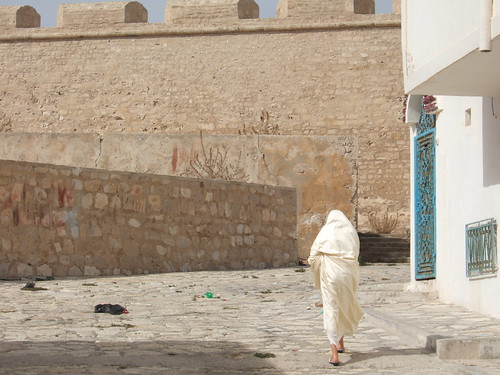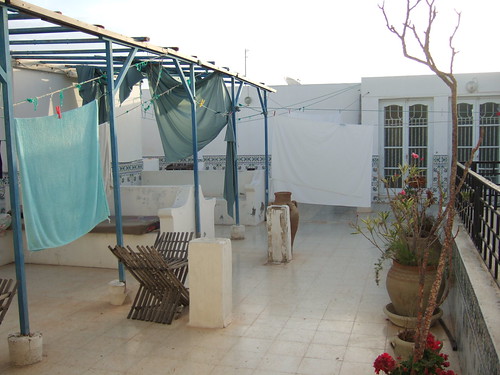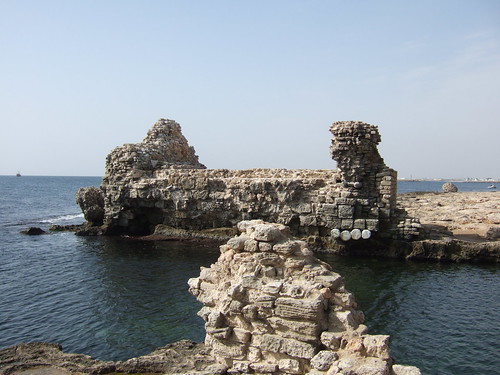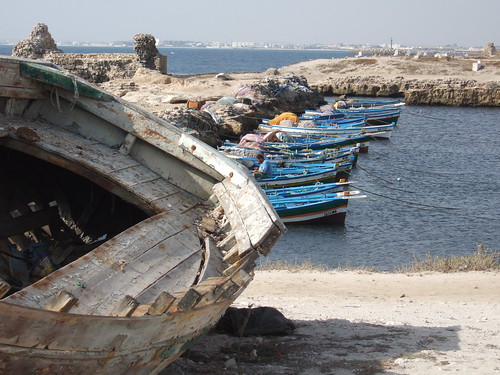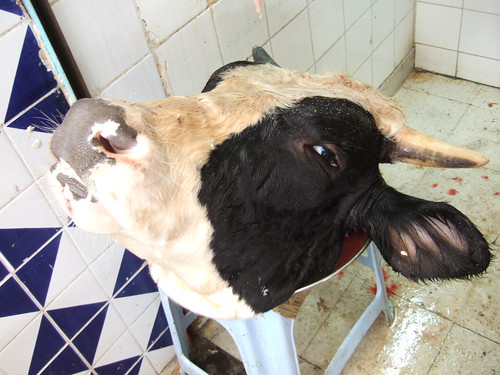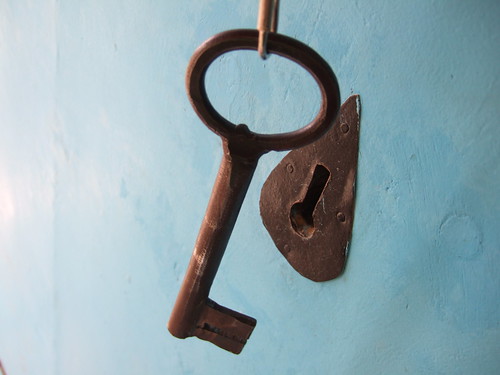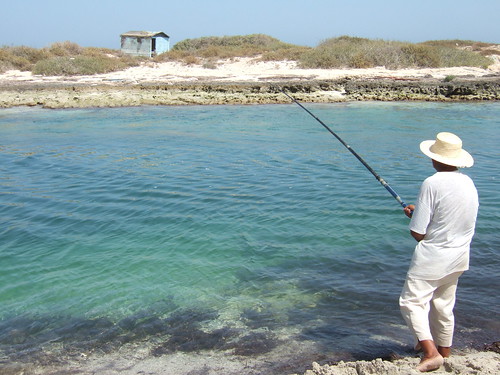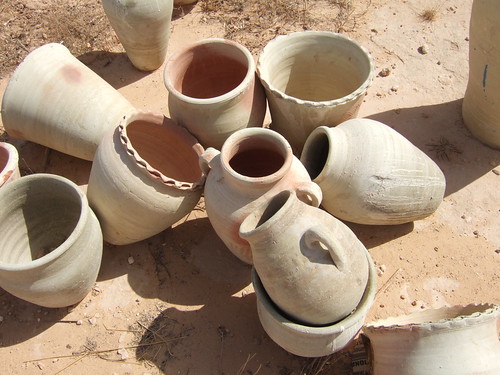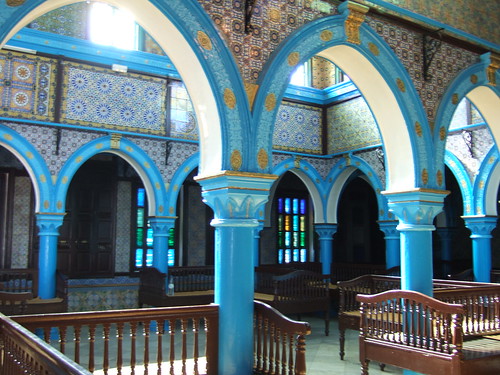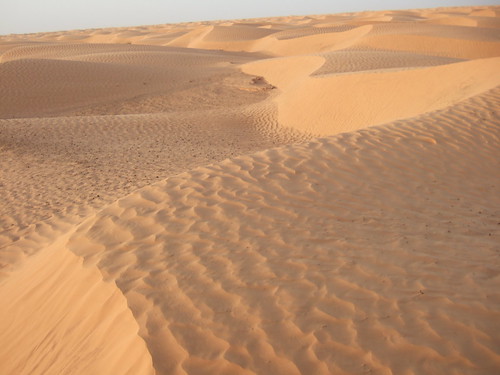We said good-bye to Houmt Souq, Jerba, and drove a long way up the east coast to Sfax. On our map, Sfax and Sousse were the two locations besides Tunis that looked like busy cities because of several roads connecting them with surrounding towns. We vowed to skip the tourist traps when we first looked at our road map, but since there was no way back up to the capital without avoiding at least one of them, we chose Sfax. In our guide book, it described Sfax as bypassed by packaged tours and the place to see what most people say is the best medina in the country.
We parked our car and walked through Bab Jebli, one of the original Aghlabid gates, an Arab Muslim dynasty. We bought some fruits to eat since no restaurant inside the medina was to open until sundown. We went inside the fish market where the action was in full swing even in the middle of the afternoon. We also walked through Souq des Etoffes where the Cairo market scenes from The English Patient were filmed. We shot one of our best videos while in there, but it was hard for me to point and shoot with my digital camera without being stared at by the locals.
The medina was a chaotic mess. Even so, we knew that they are laid out according to strict Islamic principles. We appreciated that the narrow streets kept the sun’s rays at bay, and that the stones cooled the afternoon air. We seemed to have walked for almost an hour before we found Hotel Enasser right smack in the middle of the busy market. No one we asked wanted to help us out. Some of them didn’t speak French and they waved us away or just turned their backs on us whenever we asked. By the time we checked in and paid for our 25-dinar room, we were exhausted.
When we made it back to our car, I asked the Dr. sheepishly, Can you keep driving or do you think we should stay? He agreed that we should leave for a more quiet town before it gets dark. We went back to the hotel and painfully tried to get our money back from the receptionist. I watched as he argued with the Dr. in French about how we just broke his heart by changing our minds about the town he grew up in. Yada, yada. We probably didn’t give Sfax a chance, but our first impression was that it was like Manila: polluted, crowded and noisy. We just weren’t in the mood for too many sensations at once.
So we left and kept driving up to the next town of Mahdia. It is situated along the Mediterranean and described as a small fishing village, “the sort of place to spend a few days resting from the rigours of life on the road.” That sounded good enough to us after our Sfax experience. In Mahdia, we drove on a narrow street along the water–we knew we’ve come to the right place. We parked and hauled our packs through Place du Caire and checked in a rooftop room in Hotel Medina for 15 dinars.
Sitting in the rooftop terrace as the afternoon breeze gave movement to the drying blankets was like arriving in a quiet beach after an assaulting day of getting there. We met our roof-mate, English John, who was traveling sans girlfriend. The three of us ended up having dinner together by the fishing port at Restaurant de la Medina and hunting for beer at Le Lido right after. It was weird to be talking to someone in English–I certainly felt like it was the first time I had a real conversation with anyone besides the Dr.! All this time, it had been the Dr. doing the talking in French, so English John’s company was definitely comforting.
The next day, the Dr. and I explored the coast. We walked to the fragments of the original Fatimid walls along the shoreline, through the Muslim cemetery and the Punic necropolis. We didn’t go inside Borj el-Kebir, a large fortress situated on the highest point of the peninsula, but we did end up all the way to Cap D’Afrique where the local kids jumped off sharp rocks to swim.
After spending some time on the beach and before we set off snorkeling with Subway, one of the only two water activity companies in Mahdia, we visited the markets. We were inspired enough with the excellent produce we saw that we actually planned a home-cooked meal. The spices were much cheaper than in the souqs we’ve visited, the vegetables more colorful and the meats–the meats!–were more alive! I was like a kid on Christmas day.
That night with English John, the Dr.’s four-spiced medium-rare lamb chops with fried mullets were on the menu with my watermelon tomato salad and pickled cucumber appetizer. English John walked to the same bar from the night before and provided the booze as his contribution to our night’s elaborate meal. We used our hands to eat and finished every morsel. Hands down, it was the best meal we had in Tunisia in what became our favorite place in the country.
Related post/s:
Day 9 in Tunisia: Sfax photos on Flickr
Day 9, 10 & 11 in Tunisia: Mahdia photos on Flickr
Day 6, 7 & 8: Matmata to Jerba Island, Tunisia

